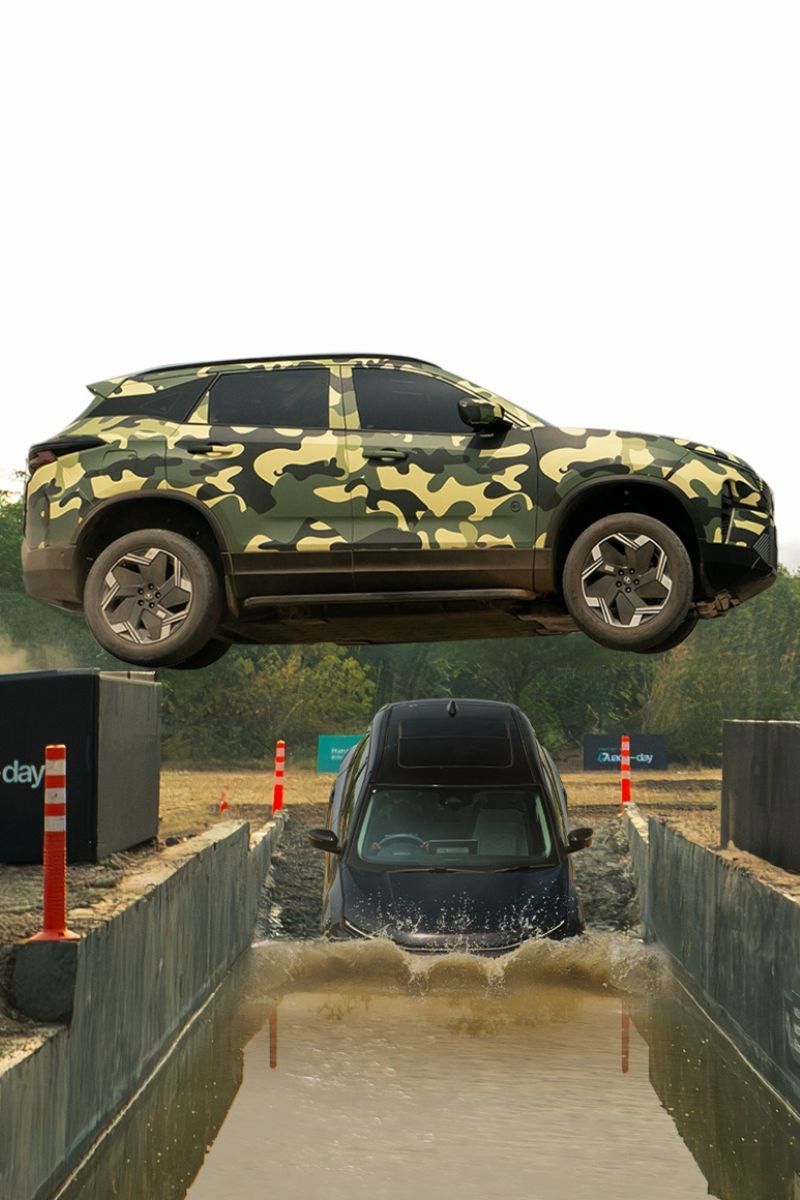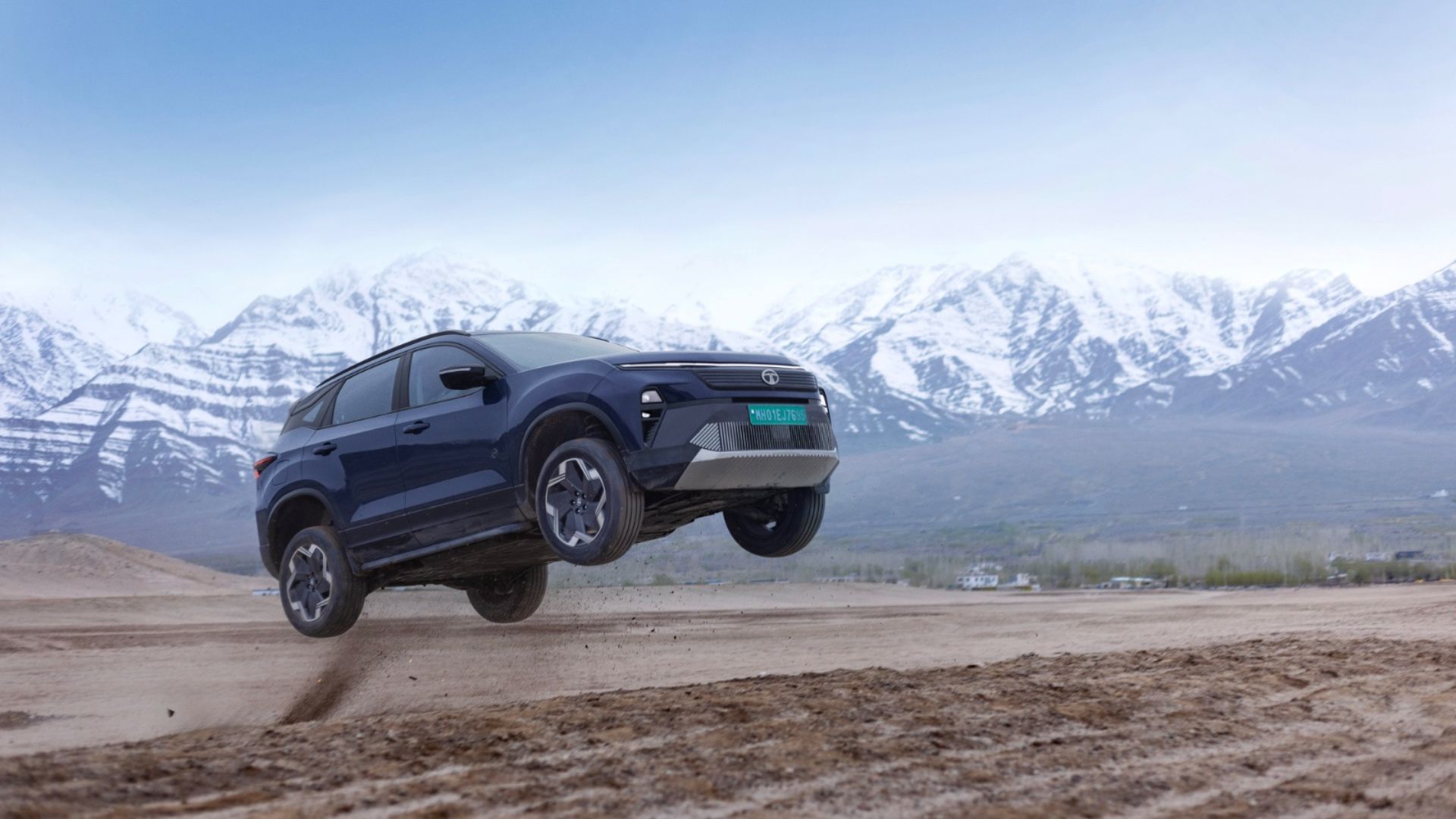The first time I floored the Tata Harrier EV on a clear stretch of the Yamuna Expressway, the speedometer shot past 150kmph and kept going. I backed off only as it nudged its 180 kmph limit. In that moment, I almost forgot I was piloting a 2.1-tonne family SUV. It’s undeniably the age of brute SUVs and the Harrier EV delivers this blend of sportscar shove and SUV confidence in spades. Tata’s flagship electric SUV manages to feel equally at home barreling down an open highway, crawling through NCR traffic, or tackling a rutted trail. The Harrier EV aims to be the only vehicle a tech-savvy, adventure-hungry driver in India will ever need, and after spending time with it through city chaos and weekend escapades, I’m inclined to believe it.
Exterior
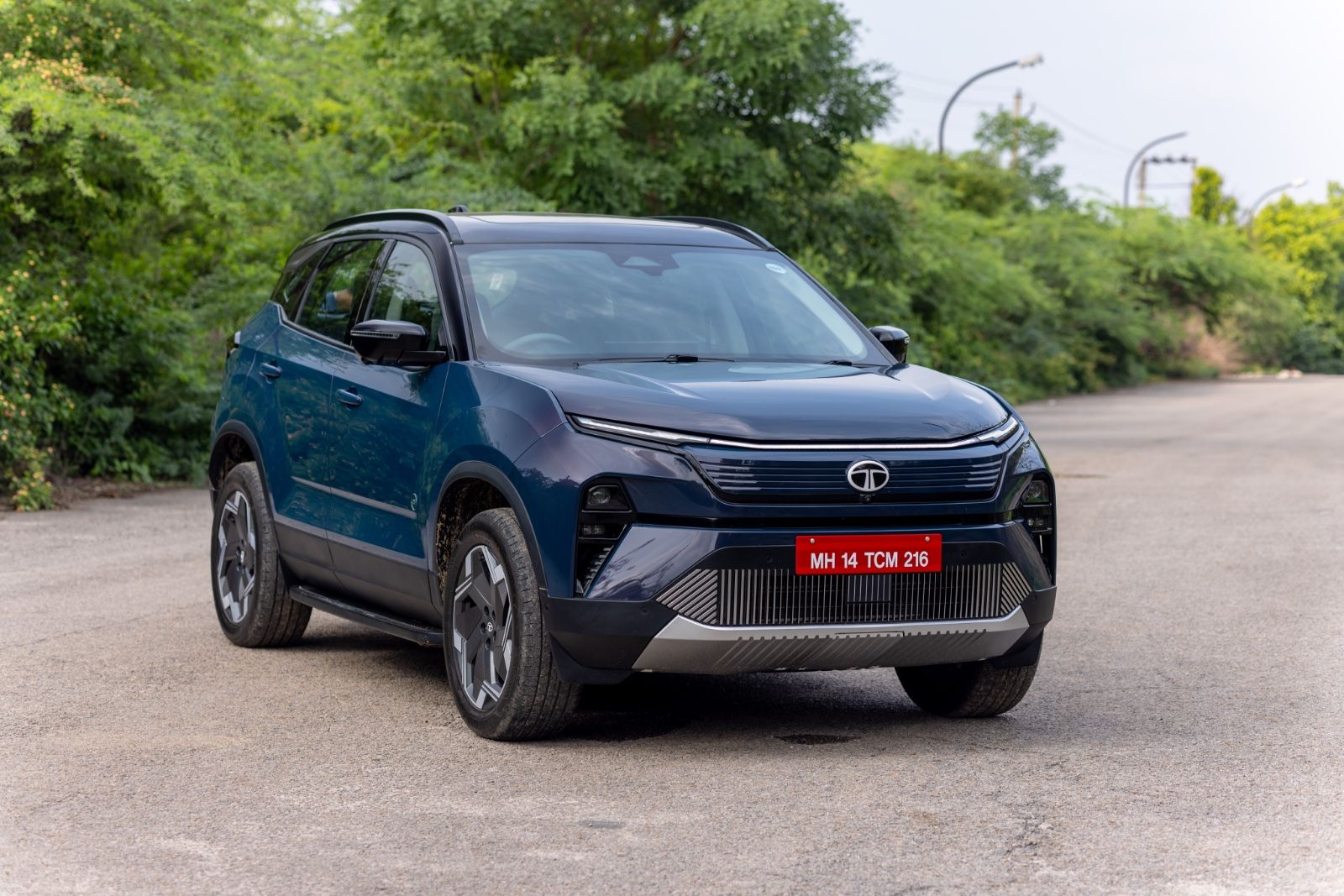
The Tata Harrier EV has a bold presence. The exterior design stays true to the Harrier’s SUV roots while integrating the carmaker's futuristic EV cues. Up front, a blanked-off grille and full-width LED DRL give it a modern, almost concept-car face, accented by sleek projector headlamps below. There’s still a strong shoulder line and squared-off wheel arches housing 19-inch alloys. The Harrier EV draws attention without resorting to gimmicky flourishes. If anything, the design is an evolution of the ICE Harrier’s handsome looks, now made cleaner. It’s an SUV that looks rugged enough for Ladakh, yet polished enough to roll up to the Oberoi without turning the valet’s head for the wrong reasons.
Slide into the driver’s seat and you’re greeted by a cabin that instantly feels premium and loaded with tech. Tata has stepped up the materials here – soft-touch surfaces on the dash, plush leatherette upholstery, and brushed metal accents. The Empowered QWD 75 variant comes loaded with tech, centered around a massive 14.5-inch touchscreen that is crisp and responsive. And thankfully, there are physical knobs for essentials like climate control, so you’re not stabbing at the screen while on the move. The interface itself is feature-rich (wireless Android Auto/Apple CarPlay, an intuitive 360° camera feed, built-in navigation, and even a JBL sound system with Dolby Atmos). Complementing it is a fully digital driver’s display that offers clean graphics and useful info at a glance.
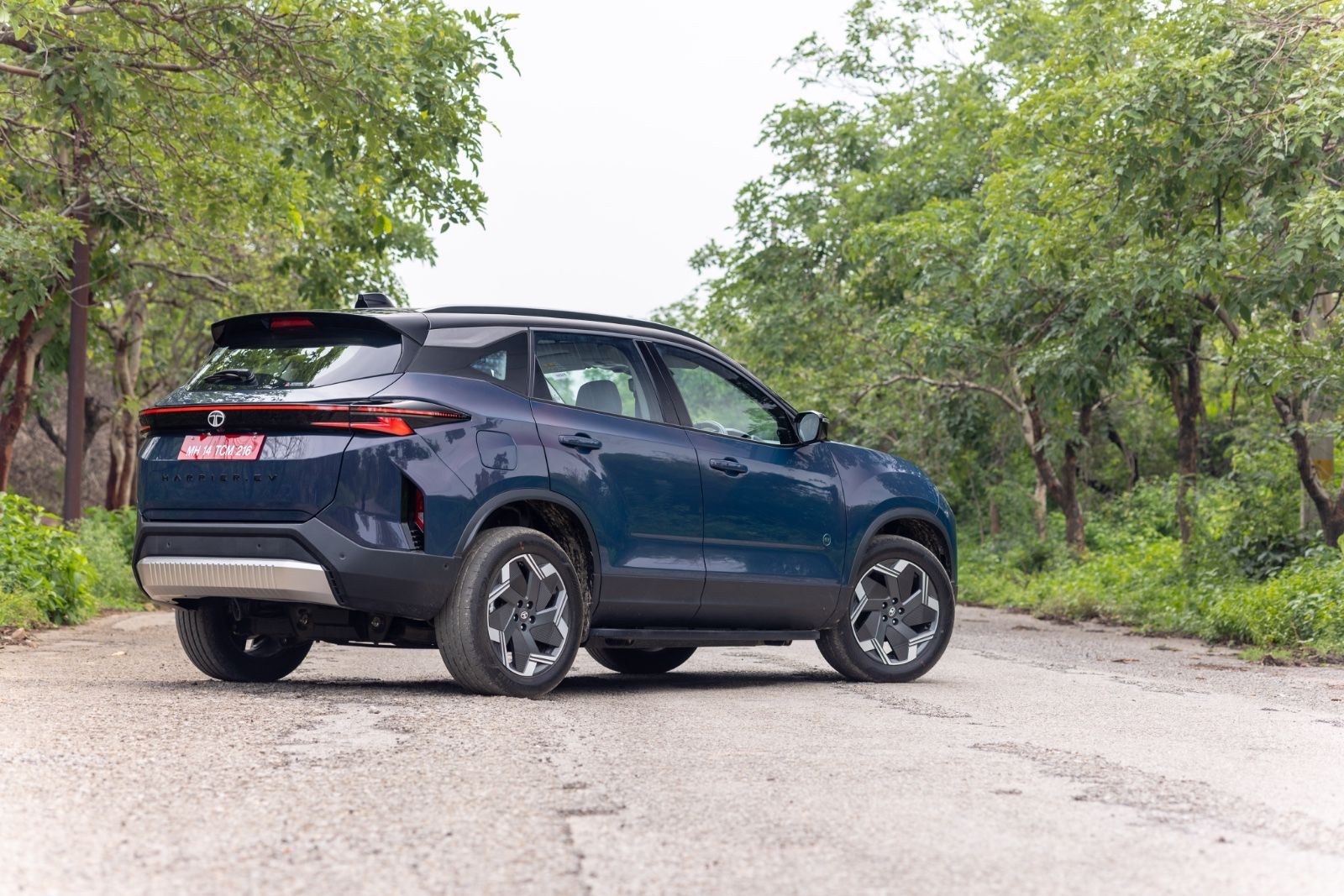
Space and comfort are top-notch in the Harrier EV. The seats are broad and supportive – after a four-hour drive, I emerged with zero backaches, helped by the ventilated driver’s seat (both front seats are ventilated) with lumbar adjustment. I did notice one ergonomic quirk carried over from the ICE Harrier – my left knee sometimes rubs against a hard section of the dashboard, which became a minor annoyance in stop-go traffic. It’s a reminder that while Tata has vastly improved its interiors, a bit more fine-tuning for driver ergonomics wouldn’t hurt. That aside, the Harrier EV’s cabin nails the luxury-meets-tech brief. From the slick digital rearview mirror (which streams a sharp, lag-free camera feed) to conveniences like ventilated front seats and a wireless phone charger, it genuinely makes your time on the road a breeze with thoughtful features.
Off-road Capabilities
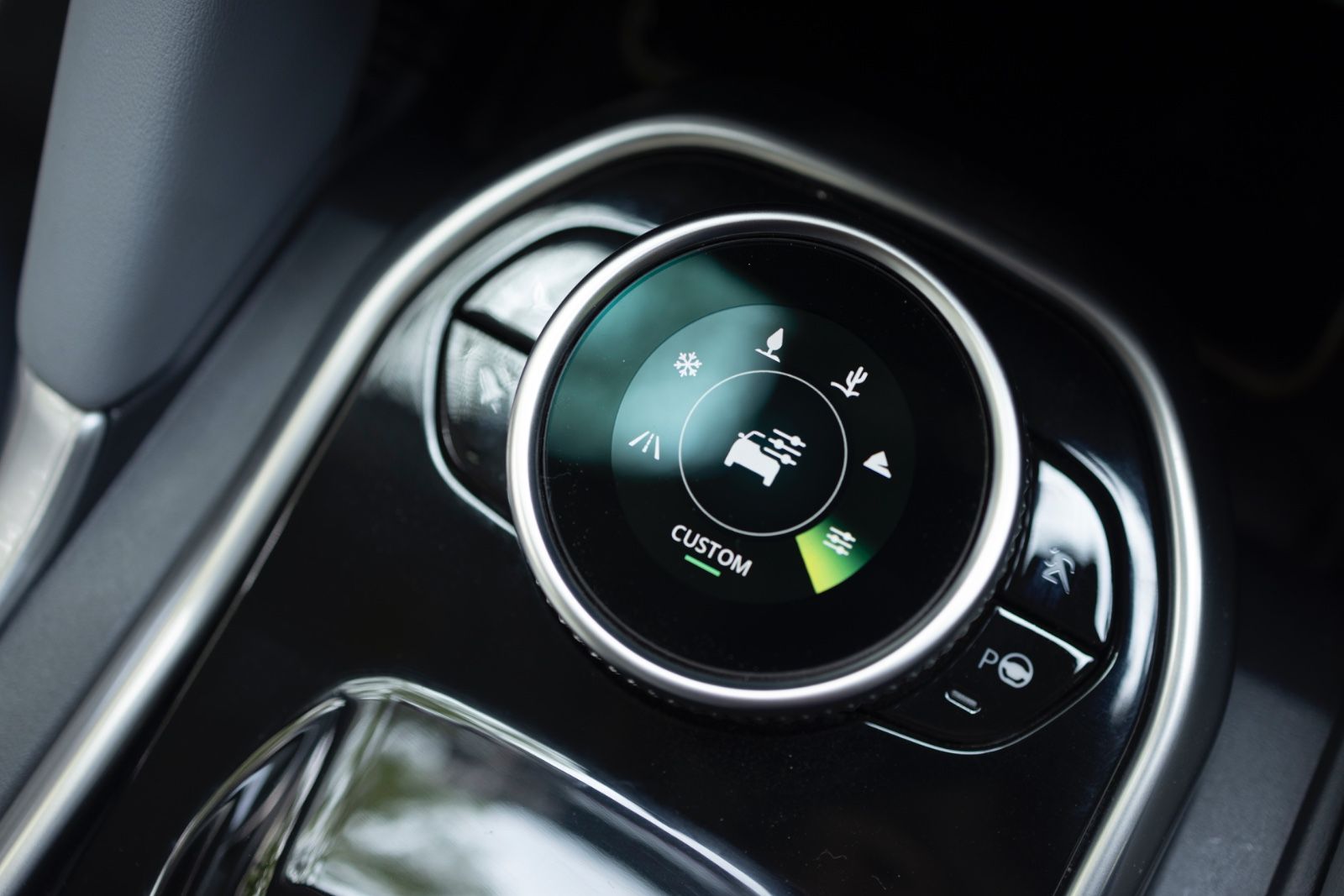
This Empowered QWD 75 is the first Tata in ages with all-wheel drive, thanks to dual motors driving both axles. In fact, it’s marketed as “quad-wheel drive,” and out on mucky trails, it’s unsurprisingly more capable. Engage the dedicated off-road modes, and you can take on mud, slush, rocks, ice and more. With Off-Road mode activated, it claws up steep inclines with ease. The instant 504Nm of torque from the electric motors makes for almost effortless rock-crawling – just a gentle squeeze of the pedal is enough to haul the 2.5+ tonne machine over obstacles. Even if a wheel did slip on wet mud, the electronics shuffled power between the front and rear so quickly that I never lost momentum. It’s almost too easy; off-road assist technology acts like a low-speed cruise control on rough terrain, meaning the Harrier can steadily progress at 5 km/h over rocks while you focus just on steering.
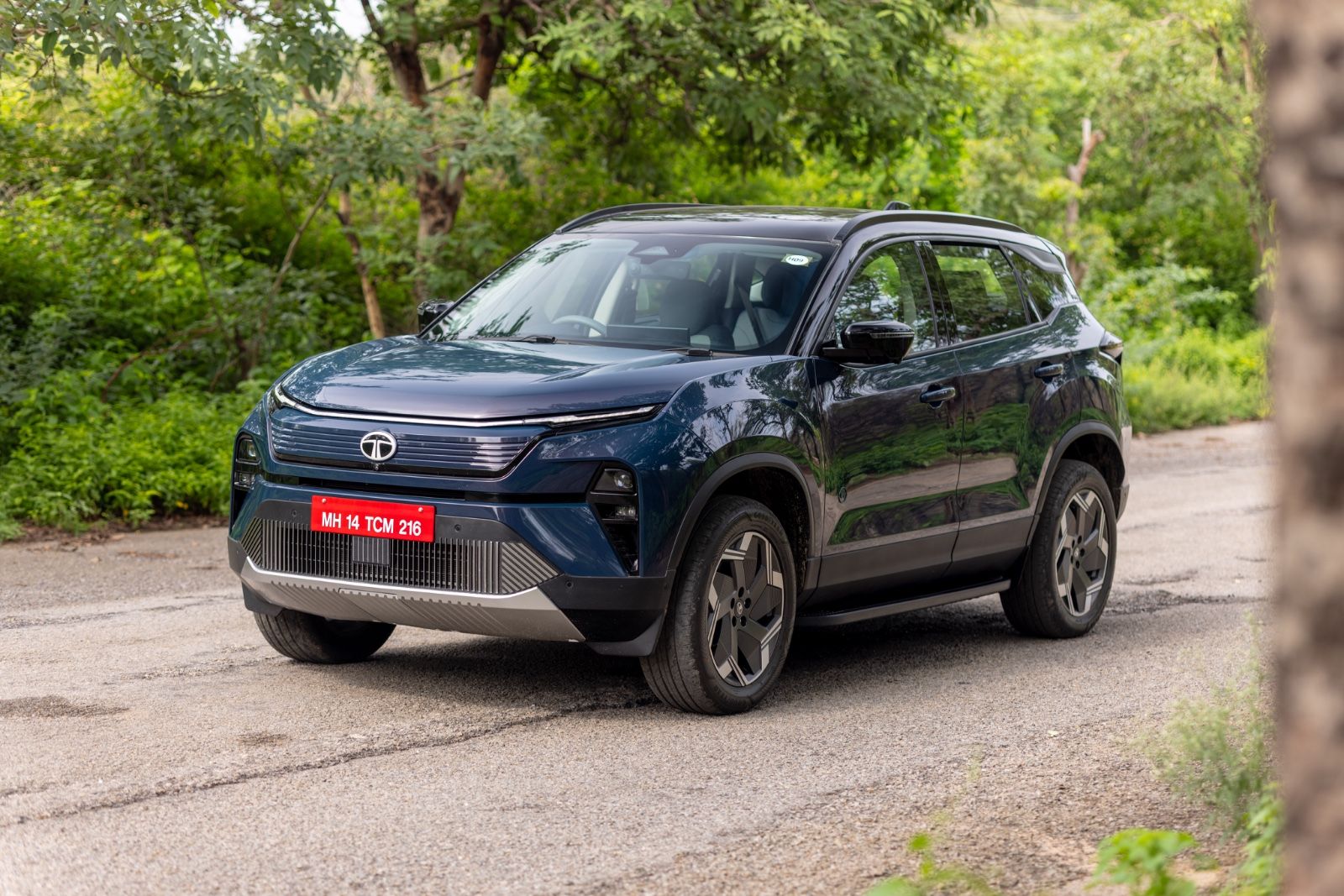
Crucially, Tata didn’t sacrifice any SUV fundamentals when electrifying the Harrier. The approach, breakover, and departure angles (25.3°, 16.6°, 26.4° respectively) are on par with traditional ladder-frame 4x4s, and with a generous ~200 mm ground clearance. The Harrier EV is rated for 600 mm of water wading. After splashing through a foot or two of water through Faridabad's flooded bylanes without any second thought, no wonder the Harrier EV emerged unfazed. The Harrier’s new independent suspension setup (with trick frequency-dependent dampers) impresses thoroughly, especially on twisty dirt tracks, by keeping the body surprisingly composed over ruts. Compared to the older diesel Harrier’s setup, there’s noticeably less side-to-side tossing; the ride feels tauter yet more absorbent. Yes, if you’re truly planning to go dune-bashing every weekend, a purpose-built 4x4 with locking diffs might still be your best bet. But for the kind of real-world off-road excursions lifestyle owners actually do – think camping by a riverside, visiting a remote farmhouse, or dealing with flooded city streets – the Harrier EV has you covered and then some. It’s an honest-to-god SUV, not just a crossover in marketing speak, and that’s a distinction worth noting.
On-road Performance
On tarmac, the Harrier EV delights the driving enthusiast with another trick up its sleeve. Tata claims a 0–100 km/h time of 6.3 seconds, and it feels every bit that quick. Mash the accelerator in Boost Mode and the initial surge is instantaneous, pinning you to the seat as this big SUV catapults ahead with a whine from the motors. Merging into fast-moving expressway traffic or making a quick overtake is effortless. In fact, that seamless wave of torque can be mildly addictive. On the Gurugram-Faridabad highway, I found myself closing gaps in traffic with ridiculous ease, zipping ahead of bewildered diesel SUVs. Yet, the Harrier EV never feels unruly. Push it into a sweeping corner and there’s acceptable body roll for an SUV this size; it tracks through confidently without the top-heavy lean you’d expect of a tall SUV. The steering, an electric unit, is tuned well for its class: light enough at parking speeds and firming up at highway pace. It’s not dripping with feedback (few modern systems are), but it is precise and nicely weighted, which encouraged me to enjoy those winding stretches.
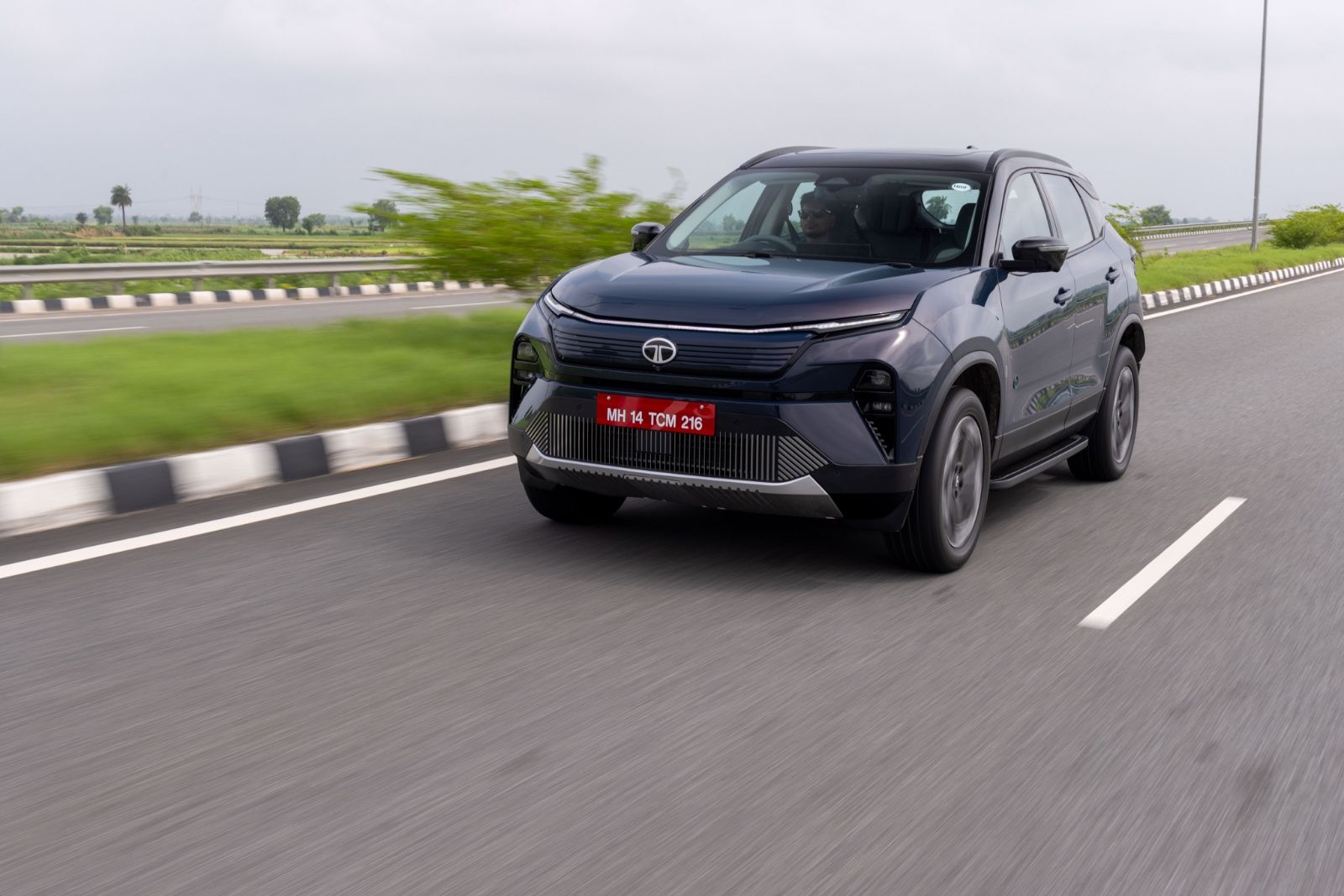
However, after repeated hard braking and aggressive sprints, I did notice the range estimation dip faster – that’s the reality of any EV driven hard. But dial back to a reasonable pace and this SUV rewards you with a relaxed, supple ride. Over broken city roads and patchy flyovers, the suspension dampens most harshness before it reaches the cabin.
EV Convenience
Living with the Harrier EV in the NCR region underscores the everyday advantages of going electric – and also highlighted a few challenges. Let’s talk range and charging first. The Empowered QWD 75, with its 75 kWh battery, boasts a claimed 622 km range under ideal conditions. In practice, with a mix of city commutes and spirited highway runs, I saw an indicated ~480 km at 94% charge, which is excellent. For context, that’s easily a Delhi to Jaipur round-trip with a top-up, or a week of office commutes and errands for most. It supports up to 120 kW DC charging, where a 20-80% session takes just 25 minutes , if you find a charger that powerful. For home charging, Tata provides a 7.2 kW AC wall box (optional extra). There are four levels of regenerative braking, and in the strongest setting you can drive one-pedal through Delhi’s stop-and-go traffic, barely touching the brake pedal.
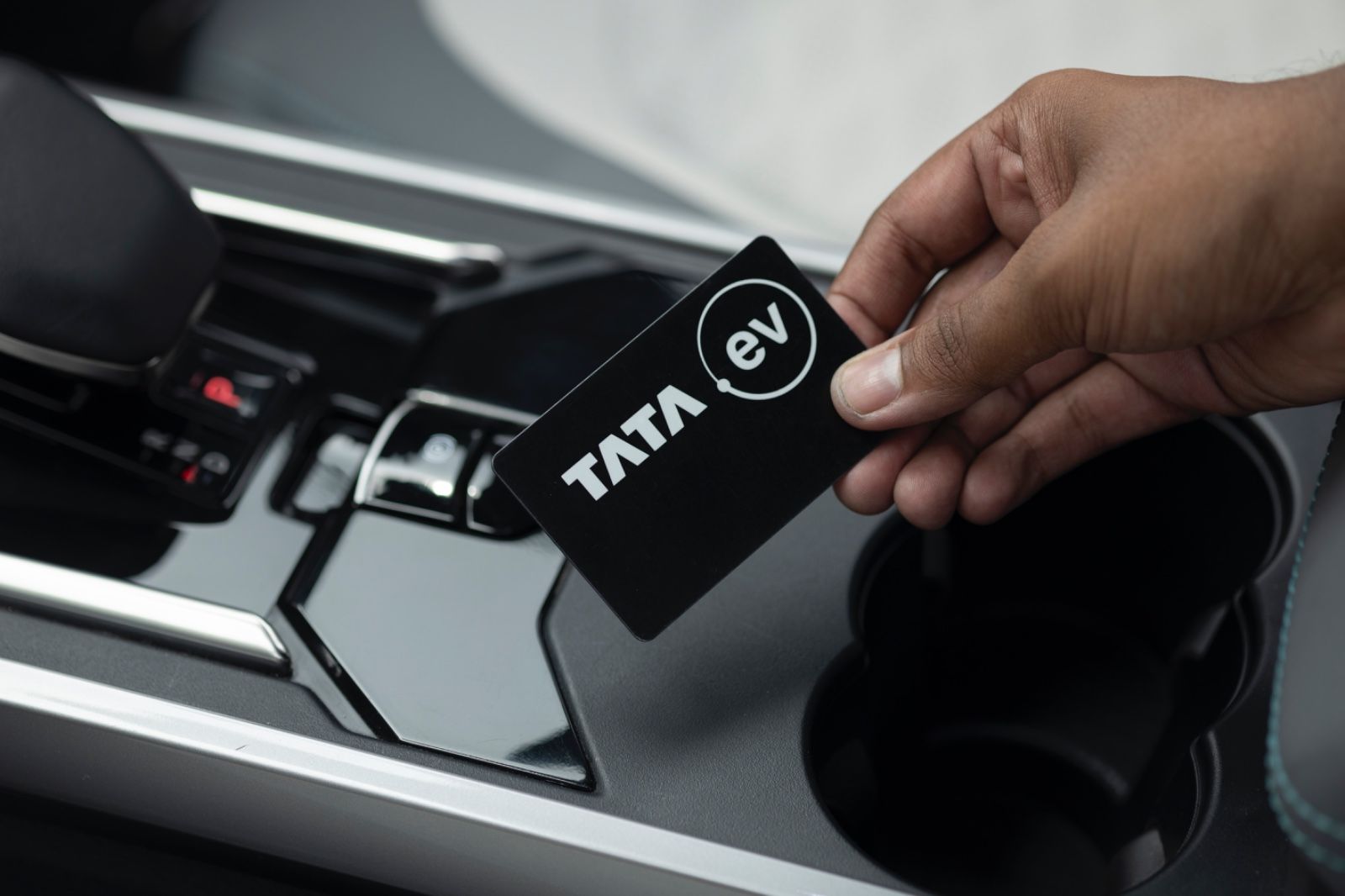
Beyond the drivetrain, the Harrier EV brings a suite of conveniences that elevate the ownership experience. The Tata.ev mobile app allows you to remotely pre-cool the cabin before stepping out in a sweltering parking lot, and even schedule charging to take advantage of cheaper night-time electricity rates. The digital key feature (using my smartphone to unlock/start the car) comes in handy if and when you forget the key fob at home. And then there’s the novelty of Vehicle-to-Load capability. It’s a party trick, yes, but one that campers and road-trippers will adore (imagine powering a mini fridge or speaker system at your campsite). Tata has also equipped this SUV with Level 2 ADAS, which, in our chaotic traffic, is a bit of a mixed bag. Features like blind spot monitoring, rear cross-traffic alert, and autonomous emergency braking are undeniably useful. While knowing that features like lane departure warning and forward collision alerts are working in the background adds peace of mind, especially on long highway slogs, they can be a hit or miss depending on how chaotic the traffic it's wading is.
Verdict
After spending a few hours with the Harrier EV Empowered QWD 75 across city streets, highways, and muddy paths, one thing is clear: Tata Motors has delivered a deeply impressive all-rounder. It comes across as a well-engineered SUV that capitalises on electrification to enhance real-world driving. Its strengths are many: blistering straight-line performance, genuine off-road capability, a spacious and feature-packed cabin, and the inherent benefits of an EV (smoothness, silence, low running costs). At around ₹29 lakh (ex-showroom) for this fully-loaded AWD variant, the Harrier EV isn’t cheap, but it positions itself below the luxury imports while offering a combination of power and all-terrain prowess unique in this class. In fact, it’s currently the only EV SUV in its segment with true all-wheel drive and such high output, an edge that should attract enthusiastic buyers. It undercuts a rival like the BYD Atto 3 on price while packing a larger battery and more capability, and it even outshines the popular MG ZS EV in performance and equipment (albeit at a slightly higher price). Mahindra’s XEV 9e will surely face an intense competition.
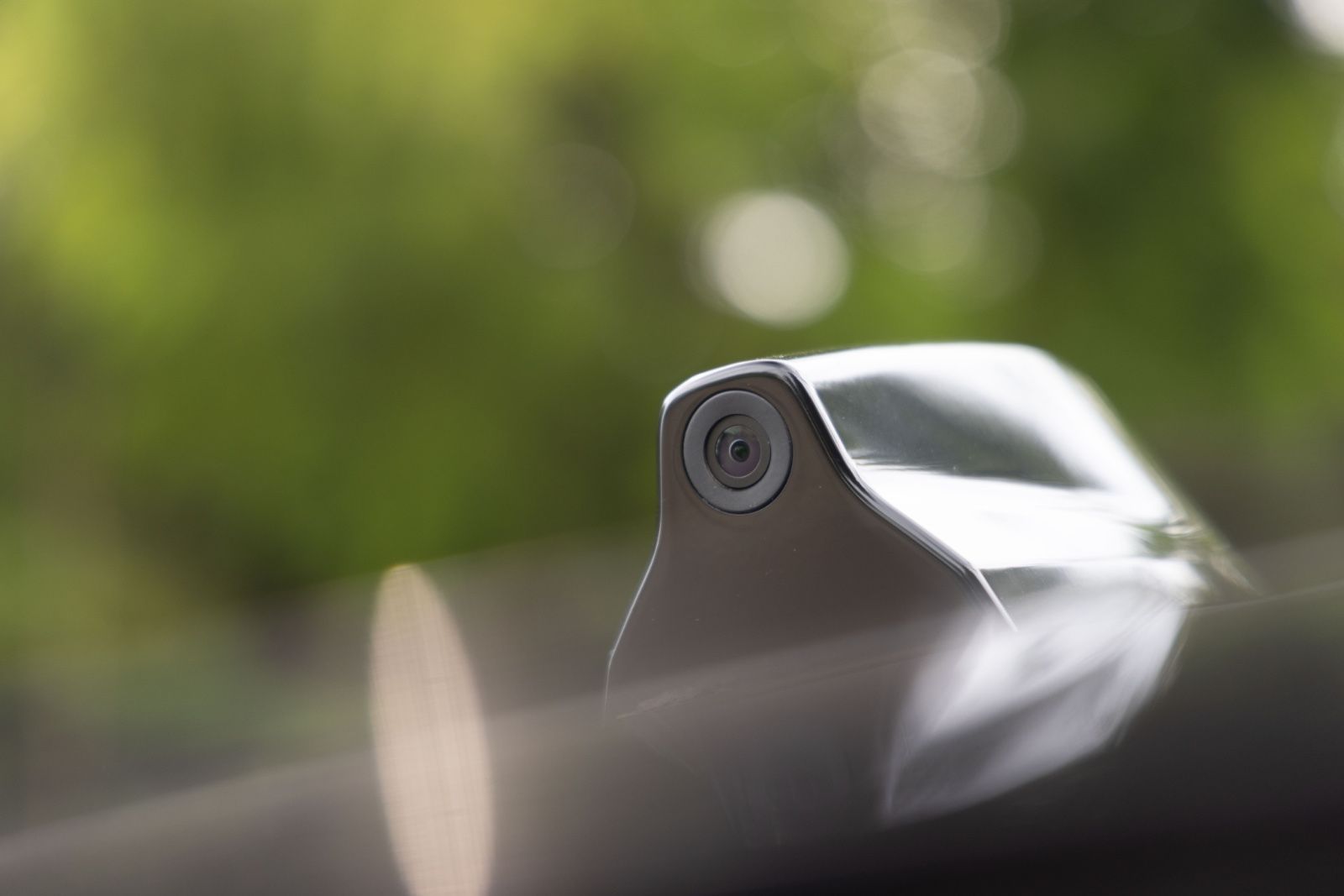
No vehicle is perfect. If I’m nitpicking, the Harrier EV’s sheer weight means it’s not as agile as a smaller crossover when darting through tight corners, and a keen driver will wish for a tad more steering feel. Also, Tata’s infotainment software – while vastly improved – could be more fluid; I experienced a couple of minor glitches. These are small blemishes on an otherwise excellent package. The bottom line is that Tata has managed to infuse the Harrier EV SUV that does exactly what it promises: delivers luxury and tech for the daily grind, and toughness and thrill for the weekend adventure. For buyers who demand a bit of everything – performance, prestige, planet-friendliness, and the ability to handle any road – Tata’s electric flagship feels tailor-made.
